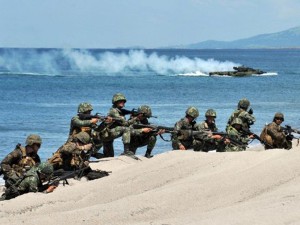
US and Philippine Marines simulate an amphibious landing as part of RP-US Amphibious Landing Exercise on a beach in San Antonio, Zambales on October 23, 2011. AFP FILE PHOTO
CLARK FREEPORT—In a rare exhibit, the Philippine and United States armed forces taking part in this year’s Balikatan military exercises on Saturday presented their aircraft for public viewing, turning the Philippine Air Force’s (PAF) Haribon flight line here into a large amusement park for children and civilians.
The display of air power was mounted to “let the people see what we are using,” Maj. Gen. Virgilio Domingo, the Philippines’ Balikatan exercise director, told reporters. Viewing was free.
Brig. Gen. Richard Simcock II, head of flight training at Clark, said the Balikatan activities were “not directed at any particular country in the region.”
“The exercises aim to improve our interoperability to enable us to address any crisis, manmade or natural,” said Simcock, replying to an Inquirer question on whether adjustments had been made in Balikatan, in light of the tension between North and South Korea.
Domingo said he was not sure if this was the first time an exhibit of this kind was staged under Balikatan, which is being conducted here for the 29th time.
Balikatan had been a periodic military exercise until the Philippine Senate rejected on Sept. 16, 1991, the 1947 Philippine-US military bases agreement.
The Balikatan resumed when the Senate approved the Visiting Forces Agreement in 1999.
Balikatan camps, however, are off-limits to reporters and civilians.
The US Marine Corps put on display an F-18 fighter jet, also known as a Hornet, an MV-22 transport plane, also called Osprey, and the KC-130 carrier.
On the Philippine side were displayed an UH-1H (Huey), an MG-520 attack helicopter, the trainer aircraft SF-260 and S-211, and the light attack turboprop OV-10 (Bronco).
Najal Flores, one of 80 students at Tacondo Elementary School in Barangay Margot in Angeles City, scampered from one aircraft to another.
Showcase for kids
“It’s their first time and they’re excited,” said Arsenia Mallare, the teacher who accompanied them to the exhibit.
Their unofficial tour guide, Technical Sgt. Ilinda Johnson, said it was not a problem showing the kids around the military hardware in the sweltering heat.
Cadet Maj. Rhea Andaya, a business administration student at the University of the Philippines, said she appreciated the exhibit. She said that because the Balikatan had been “clouded by issues,” the exhibit helped explain what the US forces were doing in the country.
“You can see the assurance of readiness of the PAF,” said Andaya, who was with 10 first class cadets of her school’s Reserve Officers’ Training Corps (ROTC).
US Marine pilot Capt. Brian Radler found himself swamped with questions from the students. “What does your F-18 jet do? How far does it go? These were the stuff of queries I got,” said Radler, who arrived on Thursday for the Balikatan.
Lt. Col. Enrico Canaya, PAF Balikatan director at Clark, said the joint training was “not about modern or old (aircraft).”
“In terms of procedures and doctrines, we are pretty much the same,” said Canaya. “This gives our Filipino pilots the opportunity to gain more knowledge on how the US operates. We learn techniques and tactics. Our pilots benefit from the exchange.”
Domingo admitted that the PAF aircraft were not at all sophisticated compared to the US air fleet. “But the aircraft we have does service for our armed forces,” he said.
Simcock said the United States was not making a permanent presence in the Philippines. “We have a rotational presence for interoperability,” he said.
According to him, the Balikatan “gives exceptional training day and night, and air to ground.”

